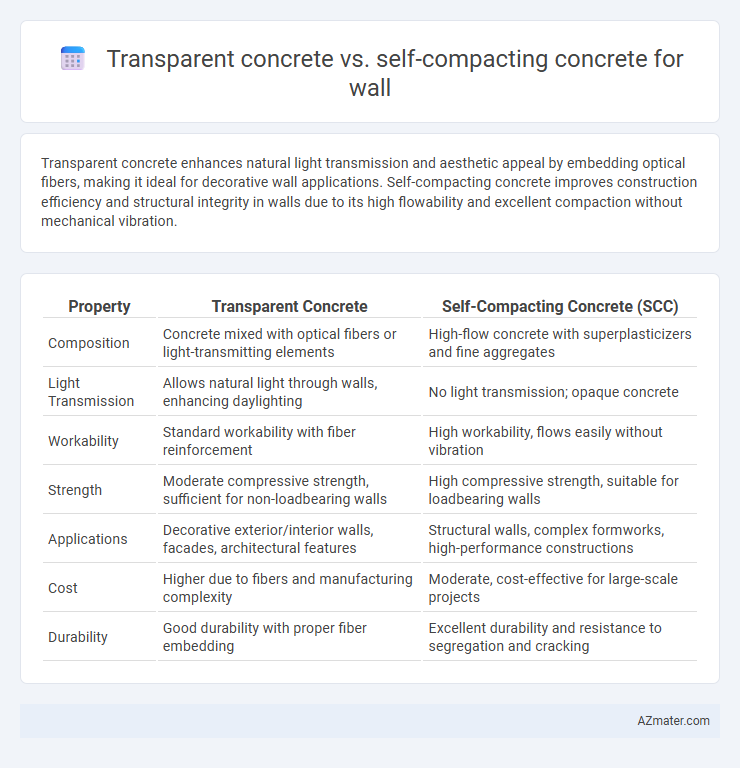Transparent concrete enhances natural light transmission and aesthetic appeal by embedding optical fibers, making it ideal for decorative wall applications. Self-compacting concrete improves construction efficiency and structural integrity in walls due to its high flowability and excellent compaction without mechanical vibration.
Table of Comparison
| Property | Transparent Concrete | Self-Compacting Concrete (SCC) |
|---|---|---|
| Composition | Concrete mixed with optical fibers or light-transmitting elements | High-flow concrete with superplasticizers and fine aggregates |
| Light Transmission | Allows natural light through walls, enhancing daylighting | No light transmission; opaque concrete |
| Workability | Standard workability with fiber reinforcement | High workability, flows easily without vibration |
| Strength | Moderate compressive strength, sufficient for non-loadbearing walls | High compressive strength, suitable for loadbearing walls |
| Applications | Decorative exterior/interior walls, facades, architectural features | Structural walls, complex formworks, high-performance constructions |
| Cost | Higher due to fibers and manufacturing complexity | Moderate, cost-effective for large-scale projects |
| Durability | Good durability with proper fiber embedding | Excellent durability and resistance to segregation and cracking |
Introduction to Transparent Concrete and Self-Compacting Concrete
Transparent concrete, also known as light-transmitting concrete, incorporates optical fibers or resin-based materials to allow natural light passage while maintaining structural integrity, making it ideal for innovative wall designs. Self-compacting concrete is a highly flowable, non-segregating concrete that spreads into place and compacts under its own weight, enhancing efficiency and surface quality in wall construction without the need for mechanical vibration. Both materials offer distinct advantages in modern architecture, balancing aesthetics, functionality, and construction performance.
Composition and Material Differences
Transparent concrete incorporates optical fibers or light-transmitting elements embedded within a matrix of traditional cement and aggregates to maintain translucency while ensuring structural integrity. Self-compacting concrete consists of a highly flowable mixture of cement, fine and coarse aggregates, chemical admixtures, and water designed to flow and settle under its own weight without segregation or the need for mechanical compaction. The primary material difference lies in transparent concrete's inclusion of light-conducting fibers for aesthetic and lighting purposes, whereas self-compacting concrete focuses on rheological properties to achieve uniform compaction and surface finish.
Manufacturing Processes Compared
Transparent concrete is produced by embedding optical fibers or light-transmitting materials within traditional concrete, requiring precise alignment and specialized casting techniques to maintain light transmission. Self-compacting concrete (SCC) utilizes a highly fluid mix design with superplasticizers and viscosity-modifying agents, allowing it to flow and settle under its own weight without segregation or mechanical vibration. Manufacturing transparent concrete involves careful integration of optical components, while SCC manufacturing focuses on optimizing rheological properties for enhanced workability and surface finish.
Structural Performance and Strength
Transparent concrete incorporates optical fibers to transmit light while maintaining comparable compressive strength to traditional concrete, offering moderate structural performance suitable for non-load-bearing walls. Self-compacting concrete exhibits superior flowability and uniformity without segregation, resulting in enhanced compressive strength and improved structural integrity for load-bearing wall applications. The choice between the two depends on balancing aesthetic translucency needs with high structural strength and durability requirements.
Light Transmission and Aesthetic Advantages
Transparent concrete incorporates optical fibers enabling up to 70% light transmission, creating visually striking walls that enhance natural illumination while maintaining structural integrity. Self-compacting concrete boasts superior surface finish and uniform texture, delivering sleek, aesthetically pleasing walls with minimal pores but lacks inherent light-transmitting properties. Choosing between them depends on prioritizing either luminous transparency or flawless, seamless wall surfaces.
Workability and Construction Efficiency
Transparent concrete offers moderate workability due to embedded optical fibers but enhances natural lighting, reducing the need for artificial lights in walls. Self-compacting concrete excels in workability with its high flowability and ability to fill complex formworks without vibration, significantly improving construction efficiency. The choice impacts project timelines, with self-compacting concrete often enabling faster placement and smoother finishes compared to transparent concrete.
Durability and Maintenance Requirements
Transparent concrete offers moderate durability with embedded optical fibers or light-transmitting elements but requires careful maintenance to prevent surface damage that can diminish its translucency. Self-compacting concrete (SCC) provides superior durability due to its dense, uniform microstructure and reduced voids, resulting in enhanced resistance to cracking and environmental stressors, which lowers long-term maintenance needs. Wall applications benefit from SCC's robust structural integrity, while transparent concrete demands specialized upkeep to maintain aesthetic and functional transparency over time.
Energy Efficiency and Sustainability
Transparent concrete enhances energy efficiency by maximizing natural daylight penetration, reducing reliance on artificial lighting and decreasing electricity consumption in buildings. Self-compacting concrete promotes sustainability through its high flowability and reduced need for vibration, which minimizes labor energy and waste generation during wall construction. Both materials contribute to eco-friendly building practices, with transparent concrete improving thermal regulation and self-compacting concrete supporting resource-efficient production methods.
Cost Analysis and Economic Impact
Transparent concrete typically incurs higher costs than self-compacting concrete due to the integration of optical fibers or light-transmitting materials, which increases production and installation expenses. Self-compacting concrete offers economic advantages by reducing labor costs and construction time, thanks to its superior flowability and ease of placement without vibration. In large-scale wall construction, self-compacting concrete provides a more cost-effective solution, while transparent concrete, despite elevated upfront costs, can add aesthetic and functional value that may justify investment in specialty projects.
Applications in Modern Wall Construction
Transparent concrete, embedded with optical fibers or light-transmitting elements, is primarily used in architectural walls to enhance natural lighting while maintaining structural integrity, ideal for modern facades and interior partitions where aesthetics and daylighting are crucial. Self-compacting concrete (SCC), known for its high flowability and ability to fill intricate molds without vibration, is favored in complex wall constructions requiring precise shapes, congestion around reinforcements, and expedited construction timelines. Both materials cater to different needs in modern wall construction: transparent concrete emphasizes visual appeal and energy efficiency, whereas self-compacting concrete prioritizes workability, durability, and streamlined construction processes.

Infographic: Transparent concrete vs Self-compacting concrete for Wall
 azmater.com
azmater.com